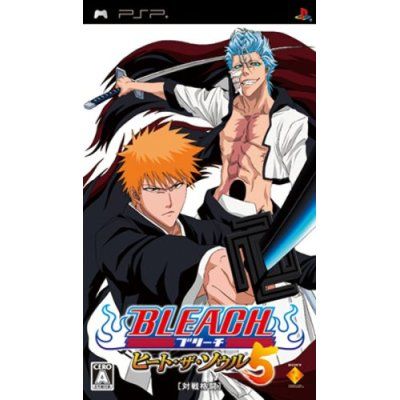
As much as I’ve always liked the concept of fighting games, my reflexes and finger dexterity generally aren’t good enough for me to do well at them beyond beginner-level difficulty. Still, I’m a pretty big fan of Bleach, and I was genuinely curious enough about how the different character powers would work in a fighting game, so I decided to give the newest installment of the Heat the Soul series a try. This is actually easier said than done since this game exists only in a Japanese version, which means there are no English instructions. Since I don’t speak or read Japanese, learning my way through the game was mainly a question of trial and error. Luckily, the menu items are in English, but I had to guess what the instructions wanted me to do.
This latest installment covers the Hueco Mundo storyline in the Bleach series, which means that it features all of the Arrancar from that storyline and de-emphasizes the shinigami characters. Virtually all of the characters who were present in previous games are still here, but some of them can only be unlocked by importing a savegame from a previous version of the game. This is a shame, because those characters include such colorful ones as Kisuke Urahara, Mayuri Kurotschi and Shunsui Kyoraku. The new arrancar includes some genuinely interesting ones like Ulquiorra Schiffer and the fully released form of Grimmjow Jeagerjaques, but unfortunately also the rather silly Privaron Espada.
Being faithful to the storyline, the single player campaign retells the story in an abridged format and works its way through all of the major fights. These fights usually have special rules and victory conditions that are inspired by the story, so that for example, in order to defeat Szayel Aporro Granz while playing Abarai Renji and Ishida Uryuu, you need to use the same finisher as seen in the show. It’s a hoot to play through these fights if you’re already a fan of the series, but the campaign is much too short to feel really satisfying.
The real meat of the game lies in its tag mode, in which you create a team of two characters and fight against other teams. As with the tag modes of other fighting games, you can switch out one character for another during the fight and even use special moves that involve both of your team members attacking at the same time. Each series of such matches culminates in a special fight against a pre-made team which serves as a sort of boss fight. For example, at the end of the first series of such matches, you get to fight the brother and sister team of Kuchiki Byakuya and Kuchiki Rukia. Winning this earns you the right to move on to the next series and unlocks various goodies including additional characters and battle stages.
To a newcomer to the series, the most striking thing about the game is the exclusive use of cel-shaded art, so that the whole thing looks and feels just like the original anime. As Valve understood when making the Team Fortress games, sometimes you don’t need your graphics to be ultra-realistic in order to look impressive. Performing some special moves also activates short cutscenes that show off the graphics further, such as Ichigo Kurosaki pulling on his Vizard mask. The game mechanics, however, are on the decidedly simple side. There are only two attack buttons for example, and the range of moves and comboes available for the different characters aren’t as varied as that of other fighting games and are mostly very easy to execute. Don’t expect the complexity of games like Soul Calibur or Virtua Fighter here. You do have a button to charge up your reiatsu, or spiritual power, that can be spent to unleash special powers and transform your character into a more powerful version. This mostly means bankai form for the shinigami characters who possess that ability or released hollow form for some of the arrancar, but fans will be happy to know that Ishida and Chad who gained new abilities over the course of the Hueco Mundo arc can access them through these mode changes as well.
The real disappointment of this game however lies in the less than stellar AI. Even at the highest difficulty level, the AI plays like a retard, frequently doing nothing while the player is charging reiatsu for example, when it could at least be spending the time charging up as well. It’s also wholly incapable of learning the player’s patterns and adapting to them, so that you can for example, win ninety percent of the matches simply by switching Ichigo into bankai form and spamming his black Getsuga Tensho projectile. The AI will simply get knocked down over and over again while it tries to rush towards the player instead of doing an air rush or dodging to one side. This means that once you learn the basics, the game is simply a cakewalk. The only real challenge is when fighting the end bosses in tag mode, and even then that’s only because they are given infinite tag energy which they can use to spam devastating special moves if you’re unluckly.
All of this adds up to it being an interesting diversion if you’re a devoted Bleach fan, but without a decent AI, even unleashing cool moves like Byakuya’s senbonsakura on mostly defenceless opponents will get old after a while.
I’m not really a big fan of Bleach anime, buty I did enjoy this game. The PSP version is a bit better in terms of graphics, but I like the DS version more.
Eh why? I would have thought that fighting games would be the genre that would least need the DS’s dual screens and touchscreen.